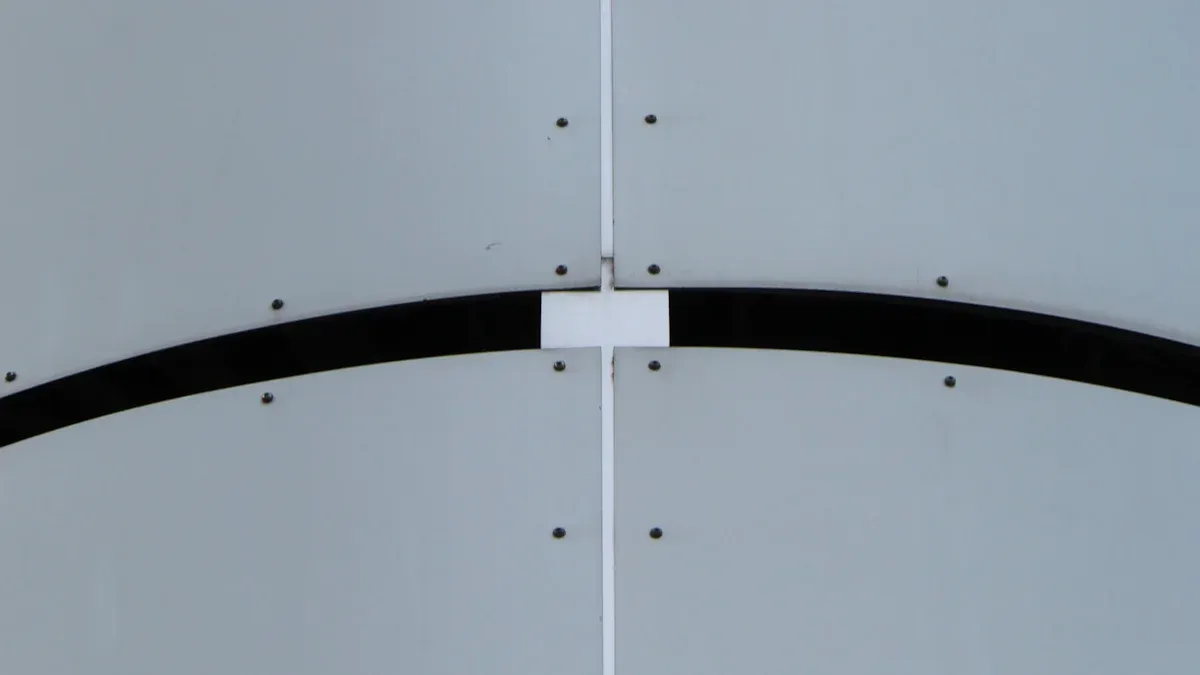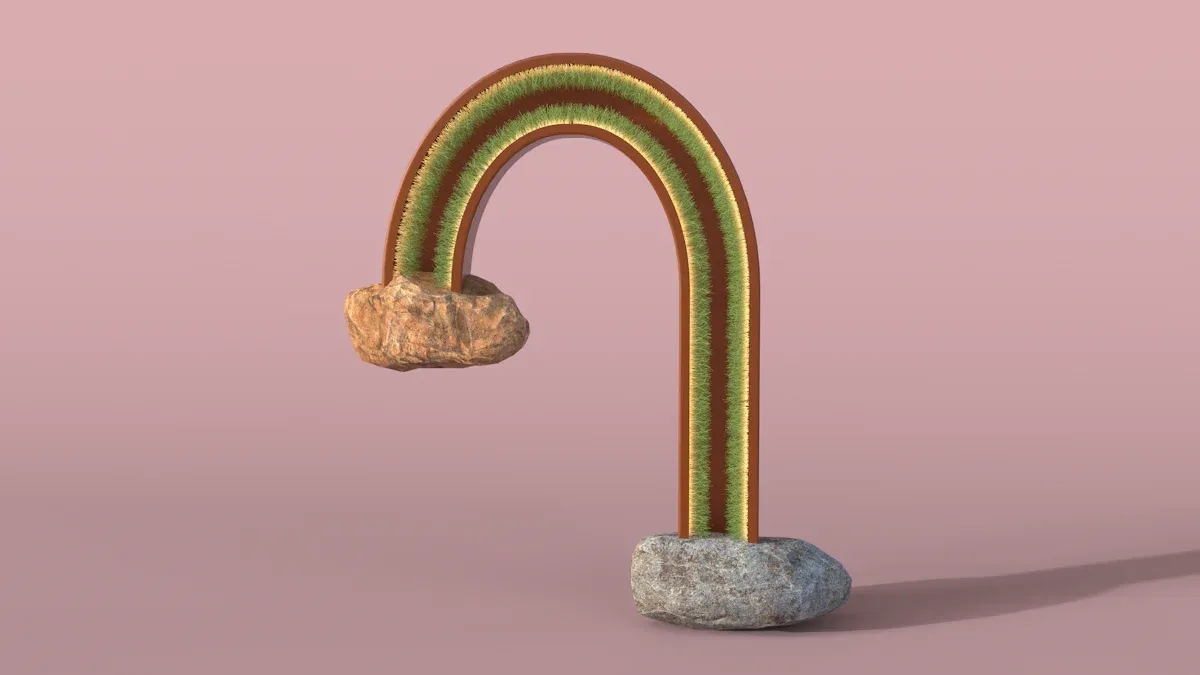A Beginner’s Guide to Memory Metal Tubing in 2025

Memory metal tubing is a special tube. It can bend or stretch and then go back to its first shape. This happens because of the shape memory effect. The metal can “remember” its shape after it is bent. In 2025, many people in medicine and industry want this tubing. Shape memory alloys are strong and can bend easily. These features make memory metal tubing helpful for many new devices and buildings today.
Key Takeaways
Memory metal tubing can bend or stretch. It goes back to its first shape because of the shape memory effect. - Nitinol is a nickel-titanium alloy. It is the most common material for memory metal tubing. This is because it is strong, bends easily, and is safe for medical use. - The tubing changes shape by moving between two phases. These are martensite and austenite. Temperature changes control this process. - Memory metal tubing lasts longer than regular metal tubing. It also returns to its shape better. This makes it great for medical devices, machines, and everyday things. - In 2025, memory metal tubing helps make medical treatments better. It also helps machines and products work well. It gives smart, strong, and bendable solutions.
Memory Metal Tubing Basics

What It Is
Memory metal tubing is a tube made from special alloys. These alloys let the tube bend, twist, or stretch. The tube can go back to its first shape. This happens because the metal has a "memory" inside it. When the tubing gets hot or cold, it can change shape. Then it snaps back to how it started. Many people use memory metal tubing in things that need to move. These things must also keep their shape for a long time.
Scientists do many tests on memory metal tubing. They check how it acts under tension, compression, and bending. For example:
Researchers use digital image correlation to see how the tubing moves.
Tests show the tubing bends better on one side than the other.
Special machines help control how the tubing is loaded for tests.
Advanced tools like X-ray diffraction show changes inside the metal.
These tests prove memory metal tubing can take lots of stress and still work well.
How It Differs
Memory metal tubing is different from regular metal tubing in many ways. Regular metal tubing bends or stretches but does not go back to its first shape. If you bend it, it stays bent unless you fix it. Memory metal tubing can "remember" its first shape. It goes back after bending or stretching.
The table below shows some main differences between types of memory metal tubing and regular tubing:
Parameter / Metric | Memory Metal Tubing (TM-1) | Memory Metal Tubing (TM-2) | Notes / Comparison Summary |
|---|---|---|---|
Strain amplitude in high-cycle fatigue | 0.5% to 1.5% higher | Lower strain amplitude | TM-1 tubing shows higher strain amplitude in long-term use |
Strain amplitude at 10^7 cycles | 2 to 3 times greater than TM-2 | Baseline | TM-1 tubing lasts longer under repeated stress |
Fatigue behavior curves | Better fatigue resistance | Lower fatigue resistance | TM-1 tubing performs better over time |
Maximum NMI inclusion length (Lmax) | Smaller or variable | Larger | Smaller inclusions in TM-1 mean better fatigue resistance |
Another table shows how the tubing works in different directions:
Property / Direction | Axial Direction (AD) | Radial Direction (RD) | Notes / Summary |
|---|---|---|---|
Elongation | Up to 22.6% higher | Lower | Tubing stretches more in the axial direction |
Maximum recovery stress | Baseline | 20.7% higher than AD | Radial direction gives better shape memory performance |
Recoverable strain | Same | Same | Both directions allow the same amount of shape change |
Note: Memory metal tubing can bend and stretch more times than regular tubing. It also goes back to its shape better, especially in the radial direction.
Memory metal tubing is stronger, more flexible, and has better recovery stress than regular metal tubing. These things make it a great choice for new products in 2025.
How It Works
Shape Memory Effect
The shape memory effect is what makes memory metal tubing special. If you bend or stretch the tubing, it can go back to its first shape. This happens because the metal “remembers” how it started. The tubing changes shape when it gets hot or cold. But it always snaps back to its set form.
Scientists check how well this effect works. For example:
Nitinol tubing can recover strains up to 5.5%. This means it can stretch or bend a lot and still go back to its first shape.
The tubing keeps working for more than 10 million cycles. It does not wear out fast.
Four main temperatures control the shape memory effect: martensite start (Ms), martensite finish (Mf), austenite start (As), and austenite finish (Af).
These changes usually happen between 200 K and 400 K. The exact range depends on how the tubing was made.
Heat treatment at 400°C to 550°C sets the tubing’s first shape. This process helps the tubing always “remember” its form.
Note: Some memory metal tubing can show a two-way shape memory effect. This means it can remember two shapes—one at a low temperature and one at a high temperature.
Scientists use special machines to test the shape memory effect. They control the temperature and measure how much the tubing stretches or bends. They use tools like resistive displacement transducers and force sensors. These tests show how the tubing changes shape at different temperatures.
Phase Transformation
The shape memory effect happens because of a phase transformation inside the metal. The tubing has two main phases: martensite and austenite. Martensite is soft and easy to bend. Austenite is strong and keeps the first shape.
When the tubing cools down, it turns into martensite. This phase lets people bend or stretch the tubing. When the tubing heats up, it turns back to austenite. The tubing then goes back to its first shape.
The change from martensite to austenite happens in steps:
Martensite start (Ms): The temperature where martensite begins to form.
Martensite finish (Mf): The temperature where martensite formation ends.
Austenite start (As): The temperature where austenite begins to form.
Austenite finish (Af): The temperature where austenite formation ends.
Transformation Parameter | Temperature Range / Values | Influence of Cooling/Heating Rate | Notes |
|---|---|---|---|
Martensite Start (Ms) | Sample dependent, usually tens of °C below austenite start | Slower cooling increases Ms due to precipitation | Hysteresis observed; not isothermal |
Martensite Finish (Mf) | -21 °C (0.01 K/s cooling) to -41 °C (5 K/s cooling) | Faster cooling lowers Mf | Precipitation affects Mf |
Austenite Start (As) | Changes with cooling/heating rate | Heating rate shifts transformation peak | Multi-step transformation |
Austenite Finish (Af) | 55.1 °C at 0.01 K/s cooling; about 48.6 °C at 0.03 K/s | Af stays nearly constant at higher rates | Transformation ends when exothermal peaks disappear |
Performance tests help scientists learn about the phase transformation in memory metal tubing. These tests include:
Ultrasonic fatigue testing, which shows how fast strain rates affect the tubing’s response.
X-ray diffraction experiments, which confirm the change from austenite to martensite by looking at the metal’s structure.
Cyclic nanoindentation loadings, which measure how the tubing reacts to repeated stress.
Tensile and compression tests, which show how much force the tubing can handle before changing phase.
In-situ nanoindentation machines, which let scientists watch the phase change as it happens.
Computer simulations, which predict how the tubing will behave under different conditions.
These tests show that both temperature and stress control the phase transformation. The tubing can switch between martensite and austenite. This makes it useful for many things. That is why memory metal tubing is important in 2025.
Shape Memory Materials
Nitinol
Nitinol is a very important shape memory material. It is made from nickel and titanium. People use nitinol because it can return to its shape. When you bend or stretch nitinol, it goes back after heating or cooling. Doctors and engineers like nitinol for its strength and flexibility. Nitinol does not rust easily, so it is safe for medical tools.
Most memory metal tubing is made from nitinol. Nitinol makes up more than 75% of the market for these alloys. The table below shows how nitinol compares to other shape memory materials:
Alloy Type | Market Share Percentage |
|---|---|
Nickel-Titanium (Nitinol) | Over 75% |
Copper-Based | Much less than Nitinol |
Iron-Based | Much less than Nitinol |
Many companies make nitinol tubing and wires. Some of the main companies are:
ATI (Nickel-Titanium Alloys)
Fort Wayne Metals Research Products Corp (Nitinol Tubing)
Nippon Seisen Co., Ltd. (Nickel-Titanium Wires, Shape Memory Tubes)
Memory Corporation (Medical-Grade Nitinol, SMA Tubing)
Xian Saite Metal Materials Development Co., Ltd. (Nitinol Tubing, SMA Wires)
Ultimate NiTi Technologies (Nickel-Titanium Medical Devices, SMA Components)
Nitinol is the top choice for shape memory alloys. Its special features make it the best shape memory material in 2025.
Other Alloys
Other shape memory materials are also used in memory metal tubing. Copper-based and iron-based alloys have some shape memory effects. These alloys cost less than nitinol. But they are not as flexible or strong as nitinol. Some industries use copper-based alloys for simple things. Iron-based shape memory materials work in some factories.
Copper-aluminum-nickel and iron-manganese-silicon alloys also show the shape memory effect. These materials help people use shape memory alloys in more ways. Still, most companies and engineers pick nitinol for important jobs. Shape memory materials are becoming more useful as new products come out in 2025.
Note: Shape memory alloys and materials help make smart devices that can change and go back to their shapes. Nitinol is still the leader, but other alloys help with special jobs.
Key Properties
Flexibility
Memory metal tubing is known for being very flexible. Nitinol is the most used shape memory material. It can bend and twist without breaking. This tubing can stretch or squeeze and then go back to its first shape. Engineers use nitinol in many devices because it can move again and again. The shape memory effect lets nitinol tubing recover from big bends. This flexibility is important for medical tools like stents and guidewires. These tools must move through small spaces in the body. Factories also use nitinol tubing in machines that need parts to bend and return to shape.
Durability
Nitinol tubing is very strong and lasts a long time. It does not wear out, even after millions of uses. Shape memory materials like nitinol do not crack easily when stressed. Clinical studies show nitinol tubing works well in devices that must last, like heart valves and bone implants. The tubing does not rust, which helps it last longer. Nitinol’s strong build makes it good for both medical and factory use. Devices made with nitinol tubing often last longer than those made with regular metals.
Biocompatibility
Biocompatibility means a material is safe for the human body. Nitinol is one of the best shape memory materials for this. Researchers found nitinol tubing is not very toxic and does not rust, like titanium. Medical experts trust nitinol for stents, heart valves, and surgery tools. Clinical tests and studies show it is safe and works well:
Nitinol tubing is as safe as titanium and has low toxicity.
Doctors use nitinol in important medical devices, like heart valve systems.
Nitinol’s superelasticity and shape memory effect help with less invasive surgeries.
Studies show nitinol stents help patients and lower problems.
The material does not cause blood clots or let bacteria grow, so implants stay safe.
Scientists keep working to make nitinol tubing even safer and better. Special coatings help lower risks like blood clots and blocked vessels. Nitinol’s mix of flexibility, strength, and safety makes it the best choice for medical and factory uses in 2025.
Applications in 2025

Medical Uses
Doctors and engineers use nitinol tubing in many devices. Nitinol’s superelasticity lets it bend and snap back. This helps surgeons do delicate work with less harm. Neurosurgeons use nitinol tubing for tools in the brain. These tools move through tiny spaces. Clinical trials show self-expanding nitinol stents help people with paralysis. Patients can control computers with their minds using these stents. They allow for careful movements, like clicking and moving a cursor.
Nitinol’s biocompatibility and corrosion resistance make it safe. Studies show nitinol stents get covered with healthy tissue in 28 days. Nickel ions stay very low, so patients are protected. Long-term studies say nitinol stents keep blood vessels open. They also lower the risk of blockages. New designs use artificial intelligence to make nitinol devices safer. This leads to faster healing and better results.
Nitinol tubing helps treat heart disease, fix blood vessels, and support new brain-computer tools.
Industrial Uses
Factories and engineers use nitinol for its strength and flexibility. Nitinol tubing works in machines that bend and return to shape. In aerospace, nitinol makes light parts that change shape during flight. Robotics companies use nitinol tubing for joints and grippers. Nitinol lasts longer than regular metals, even with heavy use. Many industries pick nitinol because it handles stress and heat without breaking.
Consumer Uses
Nitinol is now used in many everyday products. Companies put nitinol tubing in eyeglass frames, headphones, and wearables. These items bend but do not break and go back to shape. The market for shape memory alloys, like nitinol, is growing fast.
Metric | Details |
|---|---|
Market Segment | Medical Metal Tubing |
Estimated Market Value (2023) | US$ 704.2 million |
CAGR (2023-2030) | 7.4% |
Key Growth Drivers | More demand, more customers, new technology |
Geographic Focus | North America, Europe, Asia-Pacific, South America, Middle East, Africa |
Leading Companies | AMETEK Inc., Alleima, Teshima International Corporation, Om Steel Tubes Ltd., Tech Tube Inc., Vita Needle Company, and others |
Nitinol leads the market because it resists rust and works well in many products. More companies want to use nitinol, so they invest in making more. Home appliances and electronics now use nitinol parts for better use and longer life.
Scientists keep finding that shape memory alloys are flexible and strong. They are also safe to use. New reports show these materials work well in medicine and factories. Experts think there will be more uses for them soon. Smart devices and new buildings may use these metals.
Many scientists think memory metals will fix real problems in 2025 and later.
Readers can learn more about these smart materials. They might help change many jobs and industries.
FAQ
What makes memory metal tubing different from regular metal tubing?
Memory metal tubing bends and then goes back to its shape. Regular metal tubing stays bent if you bend it. Memory metal tubing is made with special alloys that can "remember" their shape.
Can memory metal tubing be used in the human body?
Doctors use memory metal tubing in many medical devices. Nitinol is safe for people and does not rust. Studies show it works well for stents, heart valves, and other implants.
How does temperature affect memory metal tubing?
Temperature changes make the tubing switch between shapes. When it gets hot or cold, the tubing changes between soft and strong. This helps it return to its original shape.
Is memory metal tubing expensive?
Memory metal tubing costs more than regular tubing. The price depends on what alloy is used and how it is used. Nitinol is the most common and often costs more because of its special features.
Where can people find products with memory metal tubing?
People can find memory metal tubing in eyeglass frames and headphones. It is also in medical tools and some smart devices. Many companies use it for things that need to bend and last longer.
See Also
Innovations Driving Laser-Cut Hypotube Tech In 2025
Nitinol Tubing Leading Medical Device Trends In 2025
How To Choose The Best Nitinol Tubing Step-By-Step
Complete Guide To Making Nitinol Microtubing For Neurovascular Use

